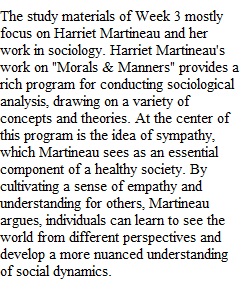


Q Across this semester, you're required to write response papers that convey your analytical response to our readings. For this paper, you'll be focusing on the reading material from week 3 of our class, so concepts/ideas from Harriett Martineau. You should only use course materials for your response paper--please do not use outside resources. Your posts are NOT SUMMARIES OF THE READINGS. Instead, you should focus on one concept (or perhaps two interrelated concepts) or ideas expressed in the reading materials for this week (see this week's module section "Important Concepts/Ideas" for some potential concepts/ideas, although you are not restricted to writing only about these concepts/ideas). Which concept/idea did you find most intriguing or powerful? The gist of the assignment is for you to engage—in an analytically sound way—with the theories (the explanations) we cover in the course. Your paper should be 2 pages (double-spaced, 1" margins, 12pt font). Finally, I'd like to help you all strengthen your citations skills, so be sure to cite properly (using ASA style) throughout, including providing a list of references (1 entry in your reference list is fine if you're focusing on 1 reading). In order to maximize your score on this assignment, you will need to convey a clear sense that you've read and understood the course material, that you can engage in an analytically thoughtful way with the material, and that you can craft your response based in the readings (while citing properly). Tips Remember, this is a social theory course. You should be engaging with the theories/concepts form a theorist, not their biography. Although you may cite some information about their biography to the extent that their biography is relevant for their theories/concepts, you should not make the theorist's biography the focus of your post. To be sure, some of the people will read are heroic and impressive individuals, but you must engage with their ideas, not summarize their biographies. When engaging in analytical writing, it's important that you always clearly identify and define the concepts/ideas you're discussing. And when you define the concepts, you should use the words of the theorist(s) to do so. After identifying and defining the concept of interest, you should then explain the concept and its significance. What does it help you/us understand about the social world? You can then also apply the concept to an example, being sure to explain why the example is an example of the concept (I recommend completing the phrase, "this is an example of the concept because..."). You could also compare/contrast the concept with another concept that you've covered in this or another course. You've only got two pages, so you should stay focused on the specific concept and avoid moving too far afield. Also, you should be careful to cite properly all sources you use. You can find information on citing in the Citation Help Module and at the Purdue Owl's website dedicated to ASA citation style Links to an external site.; pay special attention to their information on "in-text citations" and "reference page" formatting. You don't have to have a separate reference page--simply put "References" at the bottom of your papers, and then list the materials that you've cited there. Note that all of the readings in our Lemert text and all of the original theorist readings within the L&N text are formatted in accordance with the "Chapter in an Edited Volume" item on the Purdue Owl "reference-page formatting" page. This means that you cite the author of the specific reading and NOT Lemert or L&N, who are the editors of the text (except when editors have written a selection, such as this week's "Present at the Creation" reading. Note, too, that you cite the year of publication for our course texts, not the original publication date by the original author. Thus, an in-text citation for a Lemert reading is: (Authorlastname 2021) and (Authorlastname 1998) for an L&N reading. Reference page entries for each of the texts should follow the following format: Generic citation that you customize for particular reading: Authorlastname, authorfirstname authmiddleinitial. 2021. “Reading Title.” Pp. xx-xx in Social Theory: The Multicultural, Global, and Classic Readings, 7th Ed., edited by C. Lemert. Boulder, CO: Westview Press. Authorlastname, authorfirstname authmiddleinitial. 1998. “Reading Title.” Pp. xx-xx in The Women Founders: Sociology and Social Theory, 1830-1930, edited by Patricia Madoo Lengermann and Gillian Niebrugge. Long Grove, IL: Waveland Press. The proper reference page citation for an article is as follows (using the Go article as an example): Go, Julian. 2017. "Decolonizing Sociology: Epistemic Inequality and Sociological Thought." Social Problems, 64: 194-199. Rubric Response Paper Rubric (1) Response Paper Rubric (1) Criteria Ratings Pts This criterion is linked to a Learning OutcomeEngages with concept/idea from this week Response papers must engage with concept(s) from this week's reading materials. 4 pts This criterion is linked to a Learning OutcomeDemonstrates depth of understanding Paper should demonstrate analytical depth so that the discussion is theoretical. There should be no inconsistencies in the student's work and the treatment of concepts should be accurate to the original theorist's use of the concepts. 4 pts This criterion is linked to a Learning OutcomeIncludes in-text & reference list citations Student should be following citation guidelines provided in class citation module and assignment comments. 2 pts Total Points: 10 PreviousNext
View Related Questions